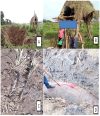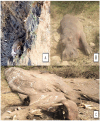Human- common hippo (Hippopotamus amphibius)-conflict in the Dhidhessa Wildlife Sanctuary and its surrounding, Southwestern Ethiopia
- PMID: 38753684
- PMCID: PMC11098388
- DOI: 10.1371/journal.pone.0303647
Human- common hippo (Hippopotamus amphibius)-conflict in the Dhidhessa Wildlife Sanctuary and its surrounding, Southwestern Ethiopia
Abstract
The common hippopotamus (Hippopotamus amphibius) is one of the most endangered mega herbivore in Africa. Although the human-hippo conflict (HHC) is currently escalating due to habitat loss, little is known about the scope of the conflict and potential mitigation measures. From 2021 to 2022, the extent of HHC, the perception of local inhabitants towards the animal, and its impacts on the conservation of the hippo were assessed within and in the surrounding areas of Dhidhessa Wildlife Sanctuary, southwestern Ethiopia. A total of 227 households were used as a data sources, participating in the questionnaire survey, focus group discussion and key informant interviews. Direct field observations were also used as key data source. Crop raiding and damage (63%, n = 143), was the most severely reported source of conflict, followed by direct human attack (22.9%, n = 52). Livestock predation and increased hippo mortality were also common types of HHC in the area. According to the study, the majority of respondents (74.4%, n = 169) agreed that the trend of conflict was increasing, while 16.7% (n = 38) argued that there was no change. Food scarcities in the buffer zone, as well as agricultural expansion in the area, have been identified as major drivers of HHC. The majority of respondents had a negative attitude toward hippo conservation; however, there were differences based on gender, age, and educational level. The major traditional hippo conflict mitigation strategies in the area include guarding, fencing, and trenching. Field observation revealed that a large extent of the former grazing and ranging areas of hippo in the area are heavily encroached and taken over by large private and public agricultural investments. Vacating and recovering at least the former buffer areas dedicated to the wildlife in the area and modern, non-lethal mitigation strategies are recommended for better conservation and safeguarding of the currently good-sized hippo population of the sanctuary.
Copyright: © 2024 Tefera et al. This is an open access article distributed under the terms of the Creative Commons Attribution License, which permits unrestricted use, distribution, and reproduction in any medium, provided the original author and source are credited.
Conflict of interest statement
The authors declare no conflict of interest
Figures






Similar articles
-
Human-hippo conflicts around Lake Tana Biosphere Reserve, Ethiopia: Vulnerability of hippopotamus in human-dominated landscape.PLoS One. 2023 Oct 5;18(10):e0291802. doi: 10.1371/journal.pone.0291802. eCollection 2023. PLoS One. 2023. PMID: 37796939 Free PMC article.
-
Human-elephant conflicts and attitude of the local communities toward African elephant (Loxodonta africana) conservation in Kafta Sheraro National Park, Tigray region, Ethiopia.PeerJ. 2025 May 22;13:e19428. doi: 10.7717/peerj.19428. eCollection 2025. PeerJ. 2025. PMID: 40416625 Free PMC article.
-
Livestock predation, crop raiding, and community attitudes towards sustainable wildlife conservation in and around Mankira Forest, Southwest Ethiopia.BMC Ecol Evol. 2024 Jun 27;24(1):85. doi: 10.1186/s12862-024-02279-2. BMC Ecol Evol. 2024. PMID: 38937724 Free PMC article.
-
Are hippos Africa's most influential megaherbivore? A review of ecosystem engineering by the semi-aquatic common hippopotamus.Biol Rev Camb Philos Soc. 2023 Oct;98(5):1509-1529. doi: 10.1111/brv.12960. Epub 2023 Apr 24. Biol Rev Camb Philos Soc. 2023. PMID: 37095627 Review.
-
Identifying the environmental and anthropogenic causes, distribution, and intensity of human rhesus macaque conflict in Nepal.J Environ Manage. 2022 Aug 15;316:115276. doi: 10.1016/j.jenvman.2022.115276. Epub 2022 May 13. J Environ Manage. 2022. PMID: 35576709 Review.
Cited by
-
Feeding ecology and activity patterns of Hippopotamus amphibious in the Dhidhessa Wildlife Sanctuary, Southwestern Ethiopia.PLoS One. 2025 Aug 8;20(8):e0325731. doi: 10.1371/journal.pone.0325731. eCollection 2025. PLoS One. 2025. PMID: 40779511 Free PMC article.
-
The diversity and habitat association of medium and large mammals in the Dhidhessa Wildlife Sanctuary, Southwestern Ethiopia.PLoS One. 2025 Mar 21;20(3):e0317441. doi: 10.1371/journal.pone.0317441. eCollection 2025. PLoS One. 2025. PMID: 40117231 Free PMC article.
References
-
- Anand S., & Radhakrishna S. (2017). Investigating trends in human-wildlife conflict: is conflict escalation real or imagined? Journal of Asia-Pacific Biodiversity, 10(2), 154–161. 10.1016/j.japb.2017.02.003. - DOI
-
- Torres D. F., Oliveira E. S., & Alves R. R. N. (2018). Conflicts Between Humans and Terrestrial Vertebrates: A Global Review. Tropical Conservation Science, 11. 10.1177/1940082918794084 - DOI
-
- Makindi S. M., Mutinda M. N., Olekaikai N. K. W., Olelebo W. L., & Abdillahi A. (2014). Human-Wildlife Conflicts: Causes and Mitigation Measures in Tsavo Conservation Area, Kenya. 3(6), 1025–1031.
-
- Seoraj-Pillai N., & Pillay N. (2017). A meta-analysis of human-wildlife conflict: South African and global perspectives. Sustainability (Switzerland), 9(1), 1–21. 10.3390/su9010034 - DOI
-
- Mekonen Eritban S. (2016). Population status and human conflict of common hippopotamus (Hippopotamus amphibius, LINNAEUS, 1758) In Boye Wetland, Jimma, Ethiopia. American Journal of Scientific and Industrial Research, 7(2), 32–40. 10.5251/ajsir.2016.7. - DOI
MeSH terms
LinkOut - more resources
Full Text Sources

